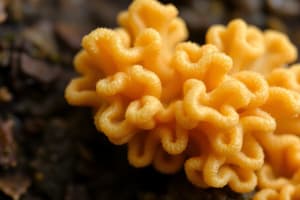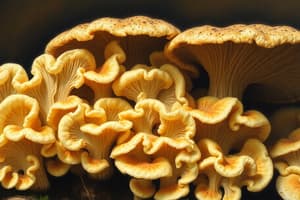Podcast
Questions and Answers
Mycelium is the vegetative part of fungi, consisting of a network of ______.
Mycelium is the vegetative part of fungi, consisting of a network of ______.
hyphae
The composition of mycelium is primarily made up of ______, a polysaccharide.
The composition of mycelium is primarily made up of ______, a polysaccharide.
chitin
Mycelium can form extensive underground networks, referred to as a ______.
Mycelium can form extensive underground networks, referred to as a ______.
mycelial mat
Mycelium plays a critical role in the process of ______, facilitating nutrient cycling in ecosystems.
Mycelium plays a critical role in the process of ______, facilitating nutrient cycling in ecosystems.
Vegetative mycelium is primarily involved in ______ absorption and growth.
Vegetative mycelium is primarily involved in ______ absorption and growth.
Flashcards are hidden until you start studying
Study Notes
Mycelium Structure
-
Definition: Mycelium is the vegetative part of fungi, consisting of a network of hyphae.
-
Hyphae:
- Filamentous structures that make up mycelium.
- Can be septate (divided by walls) or coenocytic (continuous, without walls).
- Grow in length and branched patterns to increase surface area.
-
Structure of Mycelium:
- Composition: Primarily composed of chitin (a polysaccharide).
- Growth: Mycelium expands outward through growth at the tips of hyphae.
- Mass: Can form extensive underground networks, referred to as a mycelial mat.
-
Function:
- Nutrient Absorption: Extensive surface area allows for efficient absorption of nutrients and water.
- Decomposition: Mycelium plays a critical role in breaking down organic matter, facilitating nutrient cycling in ecosystems.
-
Types of Mycelium:
- Vegetative Mycelium: Involved in nutrient absorption and growth.
- Reproductive Mycelium: Forms structures like mushrooms for reproduction.
-
Environmental Interaction:
- Mycelium can interact symbiotically with plants (mycorrhizae) or act as pathogens.
- Can connect with other fungal networks or roots, forming a larger ecosystem.
-
Adaptability: Mycelium can thrive in diverse environments, from soil to decaying organic matter, showcasing its ecological significance.
Mycelium Structure
- Mycelium is the vegetative part of fungi, composed of a complex network of hyphae.
- Hyphae are filamentous structures that make up mycelium, crucial for growth and nutrient absorption.
- Hyphae can be either septate (divided by walls) or coenocytic (continuous without walls).
- Mycelium grows by lengthening and branching hyphae, enhancing surface area for nutrient uptake.
Composition and Growth
- Mycelium primarily consists of chitin, a durable polysaccharide that provides structural support.
- Growth of mycelium occurs at the tips of hyphae, allowing for outward expansion.
- Mycelia can create vast underground networks known as mycelial mats, supporting complex ecological systems.
Functions of Mycelium
- Mycelium functions in nutrient absorption, leveraging their extensive surface area for efficient water and nutrient uptake.
- Plays a vital role in decomposition, breaking down organic matter and supporting nutrient cycling in ecosystems.
Types of Mycelium
- Vegetative mycelium focuses on nutrient absorption and supports fungal growth.
- Reproductive mycelium produces structures like mushrooms for reproduction, facilitating the continuation of the fungal cycle.
Environmental Interactions
- Mycelium can form symbiotic relationships with plants (mycorrhizae), enhancing nutrient exchange.
- Fungal networks can interconnect with each other and with plant roots, creating a larger ecosystem.
- Mycelium demonstrates adaptability, thriving in a range of environments from soil to decaying organic material, highlighting its ecological importance.
Studying That Suits You
Use AI to generate personalized quizzes and flashcards to suit your learning preferences.




